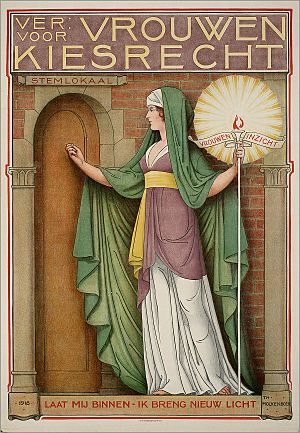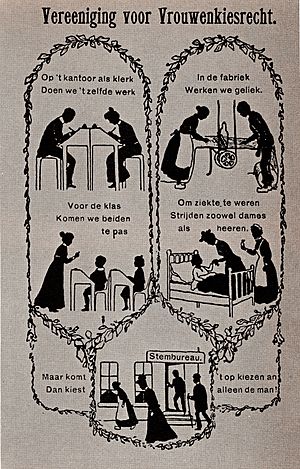Vereeniging voor Vrouwenkiesrecht facts for kids
The Vereeniging voor Vrouwenkiesrecht (which means Association for Women's Right to Vote) was an important group in the Netherlands. It worked to get women the right to vote. This organization was active from 1894 to 1919. It was the main group fighting for women's suffrage in the Netherlands. After women gained the right to vote, the Vereeniging changed its name in 1919. It later joined with other groups in 1930 and again in 1949. This organization, through its mergers, still exists today.
Contents
History of the Women's Vote Movement
The Vereeniging voor Vrouwenkiesrecht worked hard to achieve its goals. Its members met with Queen Wilhelmina of the Netherlands. They also wrote letters to members of the Dutch parliament. This was to convince leaders to support women's right to vote.
Different Ideas on How to Achieve Goals
In 1907, some members of the Vereeniging started their own group. It was called the Nederlandsche Bond voor Vrouwenkiesrecht (Dutch League for Women's Suffrage). This new group had more moderate ideas. They did not agree with some of the stronger actions used by English suffragettes. The Vereeniging itself did not use these strong actions. However, they also did not speak out against them. The two groups, the Vereeniging and the Bond, later joined together again in 1930.
After Women Gained the Right to Vote
In 1919, women in the Netherlands finally gained the right to vote. After this big success, the Vereeniging changed its name. It became the Vereniging van Staatsburgeressen (Association of Citizenesses). The group continued to work for women's independence. They also believed that a woman's role in her family was still important. The association also wrote to other organizations. They asked for women to be given important jobs and leadership roles.
Later Mergers of the Association
In 1930, the association joined with another group. This group was called the Nederlandsche Unie voor Vrouwenbelangen (Dutch Union for Women's Interests). The new combined group was named the Nederlandse Vereniging voor Vrouwenbelangen en Gelijk Staatsburgerschap. This long name means Dutch Association for Women's Interests and Equal Citizenship.
Then, in 1949, this group merged again. It joined with the Nationale Vereniging voor Vrouwenarbeid (National Association for Women's Labour). The new name became the Nederlandse Vereniging voor Vrouwenbelangen, Vrouwenarbeid en Gelijk Staatsburgerschap. This means Dutch Association for Women's Interests, Women's Labour, and Equal Citizenship. This combined organization is still active today.
Magazine Publications
The Vereeniging published its own monthly magazine. It was called Maandblad van de Vereeniging voor Vrouwenkiesrecht. After 1919, when the name changed, the magazine's name also changed. It became Maandblad van de Nederlandsche Vereeniging van Staatsburgeressen. Then, after the 1930 merger, it was called Maandblad van de Nederlandsche Vereeniging voor Vrouwenbelangen en Gelijk Staatsburgerschap.
Leaders of the Association
The Vereeniging had a main leadership team. This team usually had 9, 11, or 13 members. There was also a smaller daily management team. This team included a president, a vice president, a secretary, and a treasurer. These daily leaders did not meet often in person. They usually communicated by writing letters to each other. Men were allowed to be part of the main leadership team. However, they were not allowed to be on the daily management team.
Two important presidents of the Vereeniging were:
- 1894–1902: Annette Versluys-Poelman
- 1903–1919: Aletta Jacobs
Other important members of the board included Wilhelmina Drucker and Mien van Itallie-van Embden.
See also
 In Spanish: Vereeniging voor Vrouwenkiesrecht para niños
In Spanish: Vereeniging voor Vrouwenkiesrecht para niños
- Women's suffrage organizations
- List of suffragists and suffragettes
- Timeline of women's suffrage



